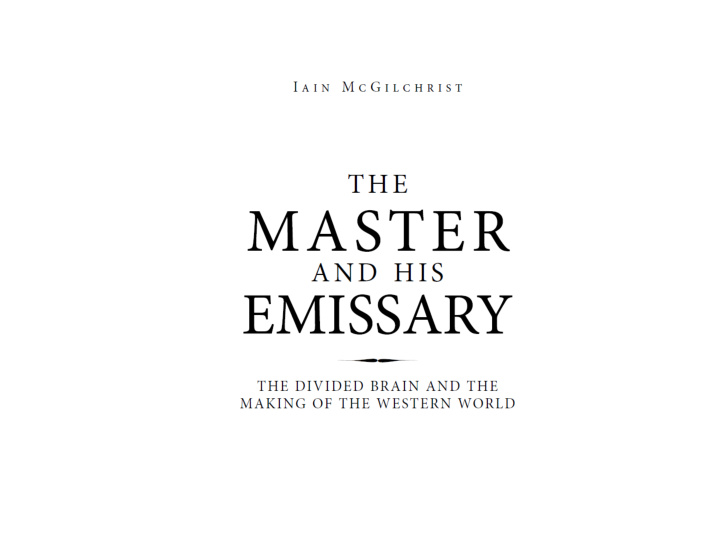



Figure 4.1 Drawing hands by MC Escher
Figure 1.2 The brain viewed from above, with right hemisphere displaced to reveal the corpus callosum
Figure 1.1 Embryonic origins of the cerebral hemispheres
Rolandic fissure (or central sulcus) Sylvian fissure frontal lobe parietal lobe occipital lobe cerebellum temporal lobe Figure 1.3 The brain viewed from the left side, showing main regions and landmarks
anterior cingulate cortex limbic system dorsolateral prefrontal ventromedial cortex cortex orbitofrontal cortex Figure 2.2 Prefrontal cortex
Figure 1.5 Yakovlevian torque (brain viewed from below)
Some areas of difference • • breadth and flexibility v focus emotional asymmetry and grasp – emotional receptivity • – the new v the known emotional expressivity • – differences in emotional affinity possibility v predictability • • reason v rationality integration v division • • the twin bodies the hierarchy of attention • • meaning and the implicit the whole v the part • • music and time context v abstraction • • depth individuals v categories • • self-awareness and emotional the differences in sameness timbre • the personal v the impersonal • moral sense • living v non-living • the self • empathy and ‘theory of mind’
Figure 2.14 Duck-rabbit
Figure 2.15 Necker cube
Figure 2.4 H composed of Es and 4 composed of 8s
Figure 2.6 Emergence of the Gestalt
Figure 2.8 Drawings of a man by a subject with a right parietal lesion, and of a bicycle and a house by a subject with a right parieto-occipital lesion (from Hécaen & Ajuriaguerra 1952)
Figure 2.5 Templates (left column) copied by patients with neglect (right column)
Figure 2.9 Tree drawn by the same subject: under normal conditions; with the right hemisphere inactivated; and with the left hemisphere inactivated (from Nikolaenko 2001)
Figure 2.10 Flower as drawn by the same subjects: in normal conditions; with the right hemisphere inactivated; and with the left hemisphere inactivated (from Nikolaenko 1997)
both left only right only Figure 2.11 Table as drawn by the same subjects: in normal conditions; with the right hemisphere inactivated; and with the left hemisphere inactivated (from Nikolaenko 1997)
cube table tree person flower Figure 2.12 Everyday objects drawn ‘according to the left hemisphere’, with the right hemisphere inactivated (from Nikolaenko 1997)
left hand (RH only) right hand (LH only) pre-operative post-operative Figure 2.13 Cube drawing before and after commissurotomy. Pre-operatively, the patient could draw a cube with either hand. Post-operatively, however, the preferred right hand performed poorly (from Gazzaniga & LeDoux, 1978).
Figure 1.5 Yakovlevian torque (brain viewed from below)
Broca’s area Wernicke’s area planum temporale (within Sylvian fissure) Heschl’s gyri Figure 1.4 The language areas of the left hemisphere
right hemisphere : left hemisphere : higher the holy lower values in service values in service of lower of higher values of the intellect ( geistige Werte ) values of vitality ( Lebenswerte ) values of use and pleasure Figure 4.3 Hierarchy of values, after Scheler
The hall of mirrors • the natural world • culture • the body • art • religion
The left hemisphere world … • loss of the broader picture • knowledge replaced by information, tokens or representations • loss of concepts of skill and judgment • abstraction and reification • bureaucracy (Berger): – procedures that are known – anonymity – organisability – predictability – justice reduced to mere equality – explicit abstraction • loss of the sense of uniqueness
… the left hemisphere world … • quantity the only criterion • ‘either/or’ • reasonableness replaced by rationality • failure of common sense • systems designed to maximise utility • loss of social cohesion • depersonalisation • paranoia and lack of trust • need for total control • anger and aggression • the passive victim
…the left hemisphere world • art conceptual – visual art lack a sense of depth, and distorted or bizarre perspectives – music would be reduced to little more than rhythm – language diffuse, excessive, lacking in concrete referents • deliberate undercutting of the sense of awe or wonder • flow just the sum of an infinite series of ‘pieces’ • discarding of tacit forms of knowing – ‘network of small complicated rules’ • spectators rather than actors • dangerously unwarranted optimism
Recommend
More recommend